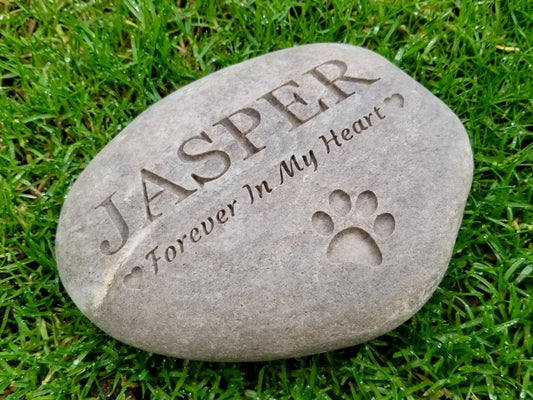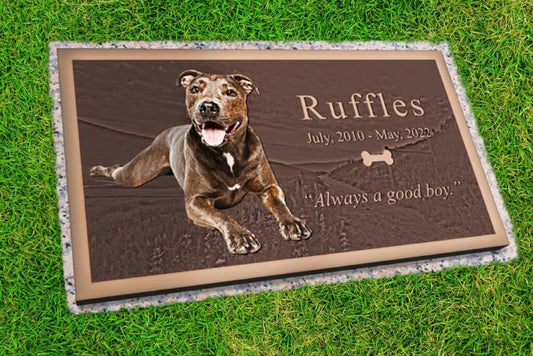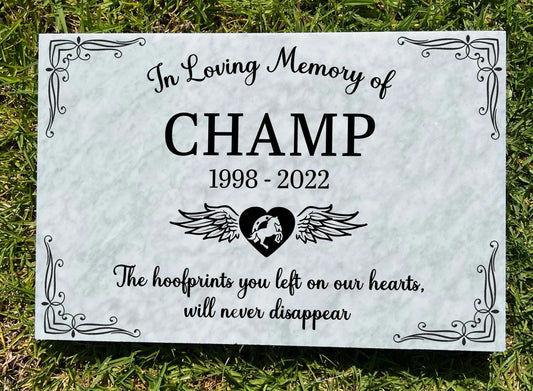Learn how to help your child navigate pet loss with expert guidance on grief support, memorial options including pet grave markers, and healing activities that honor your beloved companion's memory.
The moment arrives without warning, your child's best friend, confidant, and daily companion is gone.
While adults understand death's finality, children process pet loss differently, often experiencing their first encounter with grief through the loss of a beloved cat, dog, or other cherished animal.
Research from the American Academy of Child and Adolescent Psychiatry shows that pet loss can trigger genuine grief responses in children, complete with denial, anger, bargaining, depression, and acceptance.
The intensity often surprises parents who underestimate the human-animal bond's profound impact on developing minds.
Understanding Your Child's Grief Journey

Age-Specific Responses to Pet Loss
Ages 3-5: Young children may not grasp death's permanence. They might ask repeatedly when their pet is coming home or express confusion about why their companion isn't eating or playing.
Ages 6-9: School-age children understand death but may blame themselves. "If I had fed him more treats" or "Maybe she got sick because I didn't walk her enough" are common guilt responses.
Ages 10-13: Pre-teens experience complex emotions including anger at veterinarians, parents, or even the pet for "leaving them." They may also worry about other family members or pets dying.
Teenagers: Adolescents often feel embarrassed by their intense grief over "just a pet," leading to isolation and complicated mourning.
Red Flags Requiring Professional Support
While grief is normal, certain signs indicate when professional help is needed:
- Persistent sleep disturbances lasting beyond two weeks
- Significant changes in eating habits
- Social withdrawal from friends and activities
- Declining academic performance
- Expressions of wanting to "join" their pet
Creating Healing Through Meaningful Memorials

Memorial activities provide children with concrete ways to process abstract emotions.
The act of creating something lasting transforms helpless grief into purposeful remembrance.
Immediate Memorial Activities
Memory Books: Have your child compile photos, write letters to their pet, or draw favorite memories. This creates a tangible connection they can revisit when missing their companion.
Paw Print Keepsakes: Clay impressions or ink prints preserve physical memories. Many families create these before saying goodbye, giving children ownership in the memorial process.
Rainbow Bridge Conversations: The Rainbow Bridge poem offers comfort to many families, providing a framework for discussing afterlife concepts that align with your beliefs.
Permanent Memorial Options
Pet Grave Markers and Headstones: For families who bury their pets, personalized grave markers provide a focal point for remembrance. Options range from simple engraved stones to elaborate granite headstones with photos and custom messages.
Memorial Garden Spaces: Create a dedicated garden area with cat memorial stones or dog grave marker ideas that incorporate your child's input. Plant flowers your pet enjoyed or herbs that attracted butterflies they loved chasing.
Custom Memorial Pieces: Consider commissioning custom dog Christmas ornaments or personalized pet Christmas ornaments that can be displayed year-round, not just during holidays.
Practical Steps for Supporting Your Grieving Child

Immediate Response (First 24-48 Hours)
Be Honest About Death: Use clear language like "died" instead of euphemisms like "put to sleep" or "went away." Confusion about terminology can create additional anxiety.
Validate Their Emotions: Statements like "I can see how much you loved Max" acknowledge their bond without minimizing their pain.
Maintain Routines: Keep regular meal times, bedtimes, and activities consistent. Grief is disorienting enough without disrupting familiar patterns.
Week One: Establishing New Rhythms
Remove or Preserve Pet Items: Ask your child what they want to keep, donate, or put away. Some children find comfort in sleeping with their pet's blanket, while others need items removed immediately.
Address Guilt: Children often blame themselves for pet deaths. Clearly explain illness, aging, or accidents in age-appropriate terms, emphasizing that nothing your child did or didn't do caused the death.
Plan Memorial Activities: Involving children in memorial planning gives them agency in their grief process. Whether choosing memorial sayings for pets or selecting cat sympathy gifts for others, participation aids healing.
Long-term Support (Weeks 2-8)
Monitor Grief Progression: Normal grief comes in waves. Expect good days followed by difficult ones, especially around feeding times, walks, or bedtime routines.
Address Anniversary Reactions: Birthdays, adoption dates, or the anniversary of death may trigger renewed grief. Plan ahead for these dates with special activities or visits to memorial sites.
Consider Pet Grave Markers Near Me: If you've buried your pet, visiting local suppliers for personalized pet headstones can become a meaningful family activity that honors your pet's memory.
Memorial Ideas That Heal

DIY Memorial Projects
Photo Memory Boxes: Collect favorite toys, collars, and photos in decorated boxes. Include letters your child writes to their pet over time.
Garden Memorial Stones: Paint stepping stones with paw prints, names, or favorite quotes. These weatherproof memorials become permanent garden features.
Donation Drives: Organize pet supply donations to local shelters in your pet's name. This transforms grief into helpful action.
Professional Memorial Options
Engraved Pet Memorial Plaques: Outdoor pet memorials with custom engravings provide lasting tributes that withstand weather and time.
Custom Christmas Ornaments: Personalized dog Christmas ornaments or custom pet Christmas ornaments keep beloved companions present during family celebrations.
Memorial Jewelry: Some families commission pendant necklaces containing pet ashes or fur, creating wearable remembrances.
When to Consider a New Pet

The question "Can we get another dog?" often comes surprisingly quickly. Children process grief differently than adults, and their timeline for considering new companions varies widely.
Timing Considerations
Wait for Emotional Readiness: New pets aren't replacements. Ensure your child understands the new animal will have different personality traits and needs.
Assess Family Capacity: Grief is exhausting. Ensure adults have emotional bandwidth for training and bonding with new pets.
Honor the Previous Pet: Some families wait until they've completed memorial projects before welcoming new animals. Others find that caring for new pets helps process grief.
Signs Your Child Is Ready
- They can discuss their deceased pet without intense emotional reactions
- They express genuine interest in caring for a new animal (not just wanting company)
- They understand the new pet won't be identical to their previous companion
- They've participated meaningfully in memorial activities
Building Resilience Through Pet Loss

Pet loss, while painful, offers children valuable lessons about love, responsibility, and life's cycles.
Children who receive appropriate support through pet grief often demonstrate increased empathy, stronger coping skills, and deeper appreciation for relationships.
The experience also provides opportunities to discuss family values about death, afterlife beliefs, and how we honor those we love.
Whether through simple memorial plaques or elaborate granite pet headstones, the act of remembering teaches children that love persists beyond physical presence.
Frequently Asked Questions
Q: How long should I expect my child to grieve?
A: Grief timelines vary significantly. Most children show marked improvement within 2-6 weeks, but anniversary reactions can occur for years. Seek professional help if grief interferes with daily functioning beyond 2-3 weeks.
Q: Should I let my child see their pet's body after death?
A: This depends on your child's age and temperament. Many grief counselors recommend allowing children to say goodbye if they choose, as it provides closure and confirms death's reality. Always prepare them for what they'll see and let them decide.
Q: What should I write on a pet grave marker?
A: Include your pet's name, dates, and a phrase that reflects their personality or your family's feelings. Popular options include "Forever in our hearts," "Best friend always," or favorite nicknames. Involve your child in choosing words that feel meaningful to them.
Q: Are expensive pet memorials worth the cost?
A: Memorial value isn't determined by price. Simple DIY projects often hold more meaning than expensive purchased items. Focus on what helps your family remember and honor your pet rather than cost.
Q: How do I handle my child's questions about pet heaven or afterlife?
A: Answer according to your family's beliefs while remaining sensitive to your child's developmental level. The Rainbow Bridge poem provides a comforting framework for families seeking non-denominational afterlife concepts.
Q: When should I remove my pet's belongings?
A: Follow your child's lead. Some need items removed immediately to avoid painful reminders, while others find comfort in keeping food bowls, toys, or bedding. There's no right timeline—honor your child's emotional needs.
Q: Can pet loss trigger anxiety about family members dying?
A: Yes, pet death often introduces children to mortality concepts, leading to worry about parents, siblings, or remaining pets. Address these concerns directly with age-appropriate discussions about human versus animal lifespans and family health.
Remember that helping your child through pet loss isn't about eliminating pain, it's about providing support, creating meaning, and building resilience that will serve them throughout life's inevitable losses.
Whether through simple memorial activities or permanent pet grave markers, the goal is helping your child understand that love continues even when our beloved companions can no longer be physically present.




